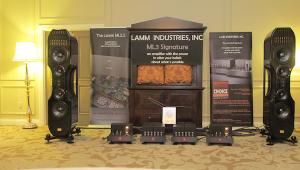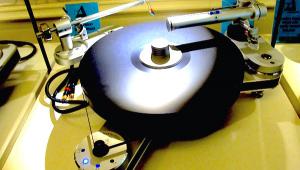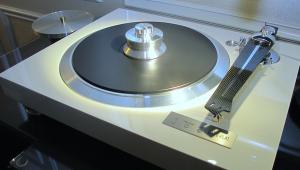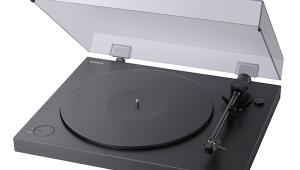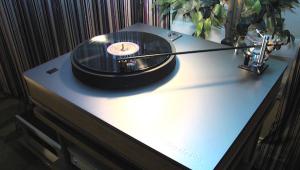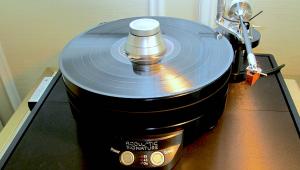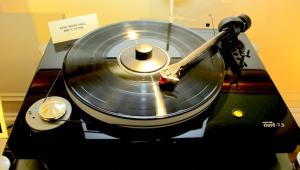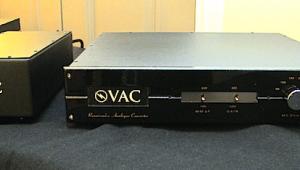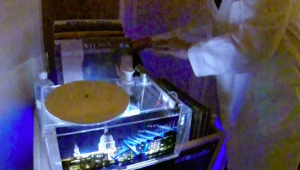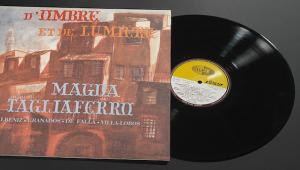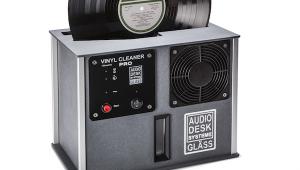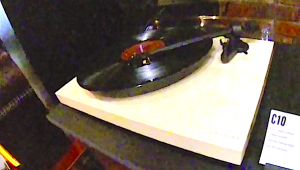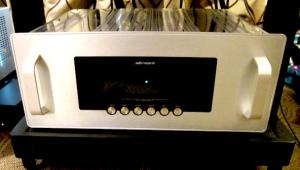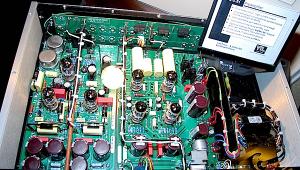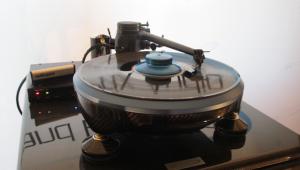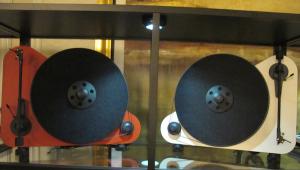I'm assuming it uses audio fingerprinting technology similar to the Shazam app, the shortcoming being that it won't work for out-of-print music. It can only recognize music that is available digitally in some form.
SweetVinyl's Brand New Product Category For Vinyl Lovers Explained

Sugarcube incorporates SweetVinyl's proprietary technology, which in part can be thought of as similar to but actually better than Gracenote's CD data base technology that allows you to put a CD into a computer, rip it to iTunes and have all of the metadata automatically be included. For those who don't fully understand: when you rip a CD, the Gracenote innovation goes online and using just the track listing and track timing, identifies the CD and then imports the metadata, including artwork and track listings.
Without it, importing CDs would be as onerous, unpleasant, time consuming and annoying as it currently is to rip vinyl where you have to insert track breaks, add song titles and other credits and import cover art. It's a pain as anyone who does it knows, though some ripping software like Pure Vinyl and Vinyl Studio try to make it somewhat easier. Both offer somewhat unsatisfactory and incomplete solutions. Pure Vinyl has greatly improved its track break process making it "automatic" to a large degree but still time consuming. Vinyl Studio can go online and download and insert track breaks but they are based upon CD lengths and often contain "bonus tracks" that have nowhere to go.
When you rip a record using SweetVinyl's technology, it accesses a remarkably compete database and identifies the record, not by track times (since they are not embedded in a record's non-existent table of contents) but rather by the music. It then automatically sets the track breaks, names the songs and imports the album cover, not the CD cover. Yes, you are skeptical but I've seen it in action in my own home before CES and while all of the glitches had not then been worked out, the system is almost ready for "prime time".
Sugarcube is the first but obviously not the last implementation of SweetVinyl's technology. It is a one box solution that combines the technology with a high quality Michael Yee designed phono preamp and...well let SweetVinyl's Leo Hoarty explain it to you. Mr. Hoarty and his business partner Dan Eakins are vinyl enthusiasts who come from the high tech Silicon Valley digital world and they know what we want and more importantly they know what they are doing. This technology will make convenient archiving your vinyl at high resolution and, for instance, uploading it to a portable high resolution player.
I think you'll find Mr. Hoarty's demonstration of Musical Surrounding's Sugarcane fascinating and perhaps even unbelievable, but trust me, it's real!
- Log in or register to post comments


I imagine they will build their own database so once someone has done a transfer of an unknown title it will be there for all future rips.

As someone who digitizes all of my records into hi res these devices will save me hundreds of man hours if implemented correctly. I hope they make one that just takes line level signal (after my pre amp) records the vinyl on to an internal hard drive and then allows me to output it to my computer/portable device with all the clicks and pops removed, tracks split and metadata entered. That would probably save me close to an hour on each album alone!
I am really looking forward to seeing all the models they will be offering and hope they come to market soon because I will be one of the first ion line for it!

I usually don't have many issues with clicks and pops, often manually taking out only the most annoying in a rip.I generally prefer to keep my album rips in one continuous file... respects the artist, though my wife hates it. I do have the ClickRepair program on my Macs and it's still running under Yosemite. It does a very good job if I'm automating the process. Sound Studio can find most of the silent passages and marker them so that saves time too.That said, I'm looking forward to seeing one of these machines in action.

And I say that someone ironically, as entering metadata has never bothered me (and it gives you something to do while you monitor the recording in progress.)
Chopping up album sides into tracks does take time, but after dealing with records and general computer stuff, this aspect isn't much of an additional hardship either. As always, the proof is in the execution, right?

I go in and marquee the damaged area, and filter only that - not the whole file. In many cases I simply trace out the pop with a pen tool.
I have tried several different automated click repair / click removal solutions and that software even at a low setting damages certain tones made by brass or the human voice - it turns these notes into the worst kind of sawtooth wave imaginable!
Nice to hear this box will tag and separate the tunes! GREAT innovation.

I absolutely agree about automated click/crackle removal seems to also interfere with the music ever so slightly... I only use it to top and tail, and manually pen draw in over the odd super loud click...

Michael,
Can you comment on the quality of the phono preamp? I'm very interested if you have any info to share.
Chris

Michael, thank you for the article and thanks to all the others for the comments. This is a very interesting thread and we are glad to hear all the positive encouragement.
The SugarCube is using audio fingerprinting and is contacting Gracenote as one poster has pointed out. We use Gracenote to check contentID against their database just like you would use your phone to check Shazam and SoundHound – but this is only one part of a larger solution needed to provide metadata that matches a vinyl album. CD metadata is different than vinyl metadata in the following areas: 1. CDs have no concept of Side A or Side B; 2. LPs have different catalog numbers; 3. LP covers are usually different than CD artwork; 4. Track timings for CD releases are often different than LPs. In addition, many CDs have bonus content and sometimes tracks are missing on the CD that were present on the vinyl release.
SweetVinyl has created its own vinyl database over a ten-year timeframe. This database is constantly growing and currently contains several hundred thousand individual titles covering all musical genres. As we continue, our goal is to provide a complete “vinyl metadata” solution as this is really what is needed to correctly archive a vinyl pressing. If something is missing, we will have a process to let users add the metadata to our database.
One of the drivers for creating this system was our own work archiving vinyl to digital for professional uses working with the record labels. This information considerably speeds up the process while using vinyl recording software such as the excellent PureVinyl product from Channel D which we use.
Automated Click and Pop removal has been a destructive process in the past – this is because the other attempts have been working on removing frequencies that alter the tonal quality of the music as one poster has pointed out. SweetVinyl is using a groundbreaking approach that accurately differentiates between music and unwanted noise. We also let the user select the sensitivity threshold and listen to the isolated noise to confirm that no music is being removed.
We are excited to bring to market this helpful technology to aid in high-quality digitization of vinyl – and ask those interested to wait to hear and see the solution for yourself before forming a judgement. We will post an A/B comparison demonstrating Click and Pop removal in the next few days to SoundCloud for those interested.
To the future of vinyl, SweetVinyl

As a note: SweetVinyl's library currently covers several hundred thousand LP titles - the equivalent of approximately three million individual tracks. This easily represents 90% of albums of interest to audiophiles.
-SweetVinyl

I can't wait for these products to come to market. It will save me many man hours!
I haven't seen all the product line yet but I hope there is one that will just have a line level input (no pre amp) and be able to get me a finished product (clicks and pops removed with metadata) that can either be stored on an internal hard drive (or attached external drive) and be easily exported to a computer/external hard drive or one that does these things with an aid of a computer. Preferably the first option.

Any plans to incorporate playback chain hardware in the metadata?
This includes the make/model of the turntable, tone arm, cartridge, stylus, and phono preamp used to make the A/D recording.
This would allow audiophiles to filter their playlist by any combination of those components, i.e. I want to hear all songs played with this tonearm, that cartridge, and/or this preamp.

Does this product automatically set the recording level? The few times I've tried to record my turntable, I first try to identify the loudest passages on the album, and set the recording level so it's barely below clipping, which requires some patience. Often times, this requires turning up the volume significantly on my amplifier compared to listening to professionally produced CDs.

I have a large collection of some pretty obscure and rare (and expensive) Italian, French, German and other prog-rock LPs.
I'd be very surprised if this intriguing device recognized even a small percentage of them.
Hopefully there will be a dealer demo close to me, so I can test it.
Not that recognizing, or not recognizing, obscure records would be a make or break feature.

I will similarly "draw" out a louder click or pop. But I've used quite a few of the click removal plugins or programs and they are all a noticeable detriment to the sound. Even a pro-level product like the Waves Restoration bundle (with click and crackle filters) has a faint effect on the imaging, but seems to be the least worst of the bunch and is the set I personally use. The main thing is to use the filters lightly, and to never use any "noise reduction" plugin, no matter who makes it. (Think of those "No-Noised" CDs...)
Plus if someone is doing a shootout of cartridges or phono stages, like Mikey does here, you definitely don't want any filter whatsoever interfering.
With really torn up records (especially 45s), both click and crackle do a great job clearing away a veil of crud. And in a record like that, we're not after the most accurate reproduction. We may just want to bring out the music to hear it better.

I also try not to run any Noise, click or crackle reduction plugins, as it alters the sound of the recording...I will however zoom in and pencil draw out individual clicks too.
The most important thing is obsessively cleaning the record before transfer.
